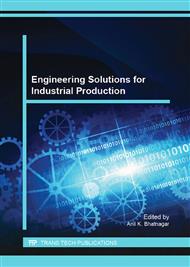p.3
p.9
p.14
p.19
p.23
p.28
p.34
p.39
Vibration Characteristics Analysis of an Elastic Cavity
Abstract:
A semi-analytical method was proposed to analyze the vibration characteristics of an elastic cavity. Combining the precise integration method and bent theory of the beam, the transfer relationship of the ends of the beam was derived. Based on the displacement continuity conditions and equilibrium equations of the junction, the conversion relation of the beams was also established. Then, the dynamics control equations of an elastic cavity were assembled by the above relationship and boundary conditions. The comparison with the FEM had verified the accuracy of the present method. This method avoids the shortage that the calculation accuracy over-depends on the element types and the mesh dividing methods, which is existed in the finite element method. In addition to this, the process of this method is efficient, so it is a useful method to the structural design and optimization of the cavity.
Info:
Periodical:
Pages:
9-13
Citation:
Online since:
July 2015
Price:
Сopyright:
© 2015 Trans Tech Publications Ltd. All Rights Reserved
Share:
Citation:


